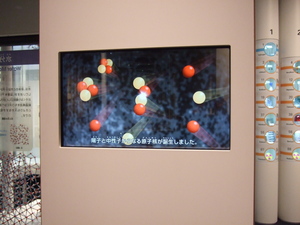Nagoya City Science Museum
TOP > Exhibition Guide > Floor Map> Birth of Atoms
Birth of Atoms



Purpose of Exhibition
We present to you in a video the atoms of our daily life: their structure, when and how they were born.
Additional Knowledge
[The Ultimate Microscopic Particle]
It was once considered that "Atoms constitute the ultimate small particles of any substance".
However, now we know that this atom consists in negatively charged small electrons and a positively charged nucleus. Furthermore, this nucleus can be broken down into protons and neutrons.
And currently, neutrons and quarks constituting protons are considered the ultimate fine particles constituting the electron lepton.
[Birth of the Atom]
About 13.8 billion years ago, almost simultaneously with the birth of the universe in the Big Bang, electrons, protons and neutrons were born. The equivalent to a single proton is a nucleus of hydrogen.
Then came the birth of hydrogen atoms and helium atoms from protons and neutrons. Then stars were born, with gravity.
The temperature went down together with the universe expansion.
About 380,000 years later, the atom nucleus trapped electrons and the atom was born.
Thus hydrogen and the helium atom were created.
Then, stars were born together with gravity. Nuclear fusion began within stars.
And then the birth of new kind of atoms continued on, one after another.
It is about 400 billion years since the birth of the universe. Until the iron atomic number 26, it has been generated this way. How the elements with an atomic number above number 27 were generated is not clearly understood. Heavy stars (with more than 10 times the mass of the sun) generated at last when supernova explosion occurred is the leading theory. Nuclear material scattered in space becomes the material of another star, and with fusion again, their atoms eventually become the body to make a living planet.
We call them 'child' stars.
[Artificial Element]
There are not known to be any naturally created elements, we say artificially created elements (however, this is not an academic term).
In accelerators, Neutrons and nucleus are mixed by collision.
Artificial elements are technetium No 43, Promethium No 61, Astatine No 85, and elements with an atomic number higher than 93 (transuranium element). There are also elements of which traces can be found in nature. Artificially created elements are all radioactive elements. Emitting radiation for a short time, they will change naturally to other elements.
[A new chemical element created in Japan]
A Japanese research team from RIKEN (a Japanese physics and chemistry institute) succeeded in the nucleosynthesis of the new element 113 by bombarding bismuth with zinc ions, in 2004, 2005 and 2012. It was officially recognized by IUPAC (International Union of Pure and Applied Chemistry) in 2015. It has become the first element on the periodic table found in Asia (Japan). IUPAC officially announced in November 2016 that the name of the newly discovered element 113 is nihonium(Nh).
Article by Keiko Ishida and Yoshitaka Yamada, curator
